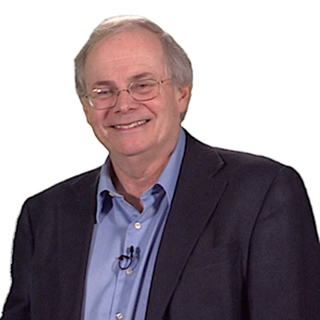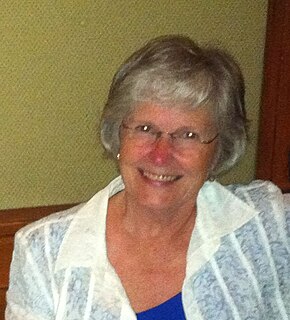Related Research Articles

Biophysics is an interdisciplinary science that applies approaches and methods traditionally used in physics to study biological phenomena. Biophysics covers all scales of biological organization, from molecular to organismic and populations. Biophysical research shares significant overlap with biochemistry, molecular biology, physical chemistry, physiology, nanotechnology, bioengineering, computational biology, biomechanics, developmental biology and systems biology.

Peter B. Moore is Sterling Professor emeritus of Chemistry, Professor of Molecular Biophysics and Biochemistry at Yale University. He has dedicated his entire career to understanding the structure, function, and mechanism of the ribosome.

Hugh Esmor Huxley MBE FRS was a British molecular biologist who made important discoveries in the physiology of muscle. He was a graduate in physics from Christ's College, Cambridge. However, his education was interrupted for five years by the Second World War, during which he served in the Royal Air Force. His contribution to development of radar earned him an MBE.
Yehudi Wyner is an American composer, pianist, conductor and music educator.
Alexander Rich was an American biologist and biophysicist. He was the William Thompson Sedgwick Professor of Biophysics at MIT and Harvard Medical School. Dr. Rich earned both an A.B. and an M.D. from Harvard University. He was a post-doc of Linus Pauling along with James Watson. During this time he was a member of the RNA Tie Club, a social and discussion group which attacked the question of how DNA encodes proteins. He had over 600 publications to his name.
Donald L. D. Caspar was an American structural biologist known for his works on the structures of biological molecules, particularly of the tobacco mosaic virus. He was an emeritus professor of biological science at the Institute of Molecular Biophysics, Florida State University, and an emeritus professor of biology at the Rosenstiel Basic Medical Sciences Research Center, Brandeis University. He has made significant scientific contributions in virus biology, X-ray, neutron and electron diffraction, and protein plasticity.

Gregory A. Petsko is an American biochemist and member of the National Academy of Sciences, the National Academy of Medicine, the American Academy of Arts and Sciences, and the American Philosophical Society. He is currently Professor of Neurology at the Ann Romney Center for Neurologic Diseases at Harvard Medical School and Brigham and Women's Hospital. He formerly had an endowed professorship in Neurology and Neuroscience at Weill Cornell Medical College and is still an adjunct professor of Biomedical Engineering at Cornell University, and is also the Gyula and Katica Tauber Professor, Emeritus, in biochemistry and chemistry at Brandeis University.
Thomas Dean Pollard is a prominent educator, cell biologist and biophysicist whose research focuses on understanding cell motility through the study of actin filaments and myosin motors. He is Sterling Professor of Molecular, Cellular & Developmental Biology and a Professor of Cell Biology and Molecular Biophysics & Biochemistry at Yale University. He was Dean of Yale's Graduate School of Arts and Sciences from 2010 to 2014, and President of the Salk Institute for Biological Studies from 1996 to 2001.
Wayne A. Hendrickson is an American biophysicist and University professor at Columbia. Dr. Hendrickson is a University Professor at Columbia University in the Department of Biochemistry and Molecular Biophysics and Violin Family Professor of Physiology and Cellular Biophysics. He is also Chief Life Scientist in the Photon Sciences Directorate at Brookhaven National Laboratory and Scientific Director of the New York Structural Biology Center. Hendrickson has a B.A. from the University of Wisconsin at River Falls, a Ph.D. in biophysics at Johns Hopkins University with Warner Love, and postdoctoral research experience with Jerome Karle at the Naval Research Laboratory (NRL). He and his colleagues use biochemistry and x-ray crystallography to study molecular properties in atomic detail with current emphasis on membrane receptors and cellular signaling, on viral proteins and HIV infection, on molecular chaperones and protein folding, and on structural genomics of membrane proteins. Hendrickson's advances in diffraction methodology have contributed significantly to the emergence of structural biology as a major force in modern biology and molecular medicine.
Carolyn Cohen was an American biologist and biophysicist. She was a Fellow of the American Academy of Arts and Sciences.

Stephen C. Harrison is professor of biological chemistry and molecular pharmacology, professor of pediatrics, and director of the Center for Molecular and Cellular Dynamics of Harvard Medical School, head of the Laboratory of Molecular Medicine at Boston Children's Hospital, and investigator of the Howard Hughes Medical Institute.

Michael Morris Rosbash is an American geneticist and chronobiologist. Rosbash is a professor and researcher at Brandeis University and investigator at the Howard Hughes Medical Institute. Rosbash's research group cloned the Drosophila period gene in 1984 and proposed the Transcription Translation Negative Feedback Loop for circadian clocks in 1990. In 1998, they discovered the cycle gene, clock gene, and cryptochrome photoreceptor in Drosophila through the use of forward genetics, by first identifying the phenotype of a mutant and then determining the genetics behind the mutation. Rosbash was elected to the National Academy of Sciences in 2003. Along with Michael W. Young and Jeffrey C. Hall, he was awarded the 2017 Nobel Prize in Physiology or Medicine "for their discoveries of molecular mechanisms controlling the circadian rhythm".

Martha Ludwig was an American macromolecular crystallographer. She was the J. Lawrence Oncley Distinguished University Professor of Biological Chemistry at the University of Michigan.
Ilme Schlichting is a German biophysicist.
Harold Abraham Scheraga was an American biophysicist and the George W. and Grace L. Todd Professor Emeritus in the chemistry department at Cornell University. Scheraga is regarded as a pioneer in protein biophysics and has been especially influential in the study of protein solvation and the hydrophobic effect as it relates to protein folding.
Carl O. Pabo is a biophysicist. He is the founder and president of Humanity 2050, a nonprofit institute.
Frank W. Putnam was an American biochemist and university professor.

Gerhard Wagner is a German-American physicist currently the Elkan Rogers Blout Professor of Biological Chemistry and Molecular Pharmacology at Harvard Medical School and is an Elected Fellow of the American Association for the Advancement of Science, German National Academy of Sciences Leopoldina, American Academy of Arts and Sciences, National Academy of Sciences and International Society of Magnetic Resonance. He is considered one of the pioneers in Biological Nuclear Magnetic Resonance (NMR) spectroscopy (Bio-NMR) and his research has been focused on protein structure, dynamics and stability, and on the relation of these to protein function. He is a structural biologist and is recognized for his work on the development of NMR spectroscopy for determination of protein structures in solution and characterizing protein dynamics.
Barry H. Honig is an American biochemist, molecular biophysicist, and computational biophysicist, who develops theoretical methods and computer software for "analyzing the structure and function of biological macromolecules."

Dagmar Ringe is an American biochemist, educator, and researcher. She is the Harold and Bernice Davis Professor in Aging and Neurodegenerative Disease at Brandeis University in Waltham, Massachusetts and holds appointments in the departments of Chemistry and Biochemistry.
References
- ↑ "Our Lab | Barnard Year of Science". yearofscience.barnard.edu. Retrieved 16 August 2022.
- 1 2 3 4 5 6 7 "Molecular Physiology & Biophysics Graduate Program | Faculty Profile" . Retrieved 4 May 2019.
- 1 2 "Electron Microscopy Facility: History of Facility". brandeis.edu. 18 January 2018. Retrieved 2 June 2019.
- ↑ The Boston Globe. 15 July 1990. p. 39.
{{cite news}}: Missing or empty|title=(help)